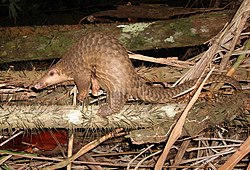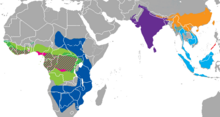Pangolin
| Pangolin Temporal range: Paleocene–Present |
|
|---|---|
 |
|
| Sunda pangolin (Manis javanica) | |
| Scientific classification | |
| Kingdom: | Animalia |
| Phylum: | Chordata |
| Clade: | Synapsida |
| Class: | Mammalia |
| (unranked): | Ferae |
| Order: |
Pholidota Weber, 1904 |
| Family: |
Manidae Gray, 1821 |
| Genera | |
 |
|
Pangolins are mammals of the order Pholidota. The one extant family, Manidae, has three genera: Manis, which comprises four species living in Asia, Phataginus, which comprises two species living in Africa, and Smutsia, which comprises two species also living in Africa. These species range in size from 30 to 100 centimetres (12 to 39 in). A number of extinct pangolin species are also known.
Pangolins have large, protective keratin scales covering their skin; they are the only known mammals with this adaptation. They live in hollow trees or burrows, depending on the species. Pangolins are nocturnal, and their diet consists of mainly ants and termites which they capture using their long tongues. They tend to be solitary animals, meeting only to mate and produce a litter of one to three offspring which are raised for about two years. Pangolins are threatened by hunting (for their meat and scales) and heavy deforestation of their natural habitats, and are the most trafficked mammal in the world. Of the eight species of pangolin, four species (Phataginus tetradactyla, P. tricuspis, Smutsia gigantea, and S. temminckii) are listed as vulnerable, two species (Manis crassicaudata and M. culionensis) are listed as endangered, and two species (M. pentadactyla and M. javanica) are listed as critically endangered on the International Union for Conservation of Nature (IUCN) Red List of Threatened Species.
The name "pangolin" comes from the Malay word "pengguling", meaning "something that rolls up".
The physical appearance of a pangolin is marked by large, hardened, overlapping plate-like scales. The scales, which are soft on newborn pangolins but harden as the animal matures, are made of keratin, the same material of which human fingernails and tetrapod claws are made. The pangolin's scaled body is comparable to a pine cone or globe artichoke. It can curl up into a ball when threatened, with its overlapping scales acting as armour while it protects its face by tucking it under its tail. The scales are sharp, providing extra defense from predators.
...
Wikipedia
